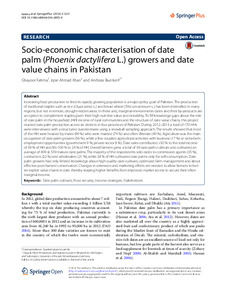| dc.date.accessioned | 2016-11-09T13:04:51Z | |
| dc.date.available | 2016-11-09T13:04:51Z | |
| dc.date.issued | 2016-08-02 | |
| dc.identifier.issn | 2193-1801 | |
| dc.identifier.other | doi:10.1186/s40064-016-2855-4 | |
| dc.identifier.uri | urn:nbn:de:hebis:34-2016110951369 | |
| dc.identifier.uri | http://hdl.handle.net/123456789/2016110951369 | |
| dc.description.sponsorship | Gefördert durch den Publikationsfonds der Universität Kassel | |
| dc.language.iso | eng | |
| dc.publisher | Biomed Central | |
| dc.rights | Urheberrechtlich geschützt | |
| dc.rights.uri | https://rightsstatements.org/page/InC/1.0/ | |
| dc.subject | Date palm cultivars | eng |
| dc.subject | Food security | eng |
| dc.subject | Income strategies | eng |
| dc.subject | Stakeholders | eng |
| dc.subject.ddc | 580 | |
| dc.subject.ddc | 630 | |
| dc.title | Socio-economic characterisation of date palm (Phoenix dactylifera L.) growers and date value chains in Pakistan | eng |
| dc.type | Aufsatz | |
| dcterms.abstract | Increasing food production to feed its rapidly growing population is a major policy goal of Pakistan. The production of traditional staples such as rice (Oryza sativa L.) and bread wheat (Triticum aestivum L.) has been intensified in many regions, but not in remote, drought-ridden areas. In these arid, marginal environments dates and their by-products are an option to complement staples given their high nutritive value and storability. To fill knowledge gaps about the role of date palm in the household (HH) income of rural communities and the structure of date value chains, this project studied date palm production across six districts in four provinces of Pakistan. During 2012–2013 a total of 170 HHs were interviewed with a structured questionnaire using a snowball sampling approach. The results showed that most of the HH were headed by males (99 %) who were married (74 %) and often illiterate (40 %). Agriculture was the main occupation of date palm growers (56 %), while a few coupled agricultural activities with business (17 %) or extra-farm employment opportunities (government 9 %; private sector 8 %). Date sales contributed >50 % to the total income of 39 % of HH and 90–100 % to 24 % of HH. Overall farmers grew a total of 39 date palm cultivars and cultivated an average of 409 ± 559 mature date palms. The majority of the respondents sold dates to commission agents (35 %), contractors (22 %) and wholesalers (21%), while 28 % of HH cultivated date palms only for self-consumption. Date palm growers had only limited knowledge about high quality date cultivars, optimized farm management and about effective post-harvest conservation. Changes in extension and marketing efforts are needed to allow farmers to better exploit value chains in date thereby reaping higher benefits from improved market access to secure their often marginal income. | eng |
| dcterms.accessRights | open access | |
| dcterms.bibliographicCitation | in: SpringerPlus. - London : Biomed Central. - (2016) 5: 1222, 1-13 | |
| dcterms.creator | Fatima, Ghayoor | |
| dcterms.creator | Khan, Iqrar Ahmad | |
| dcterms.creator | Buerkert, Andreas | |
| dc.publisher.place | London | |
| dcterms.source.issue | 1222 | |
| dcterms.source.journal | SpringerPlus | |
| dcterms.source.pageinfo | S. 1-13 | |
| dcterms.source.volume | 5 | |

